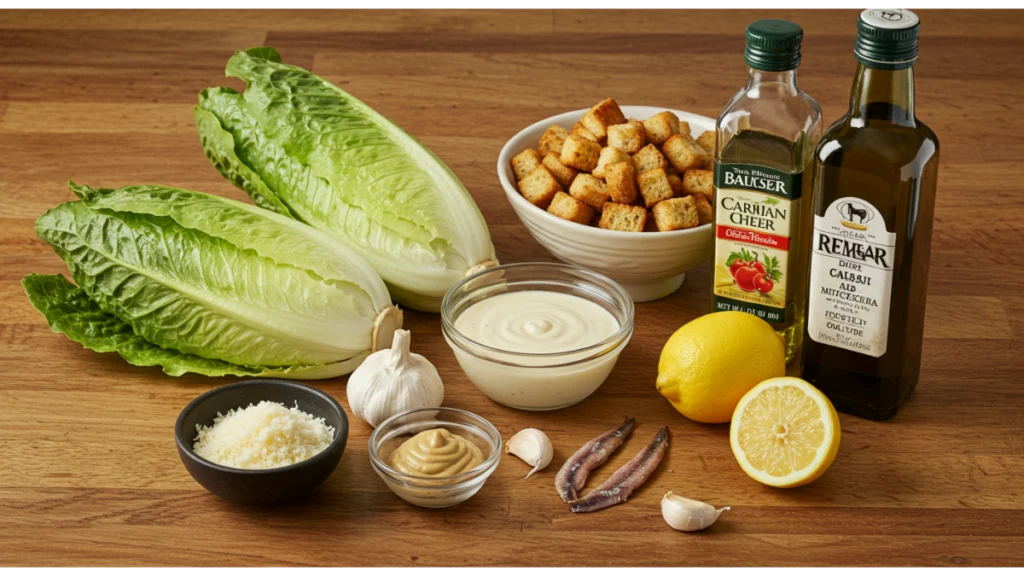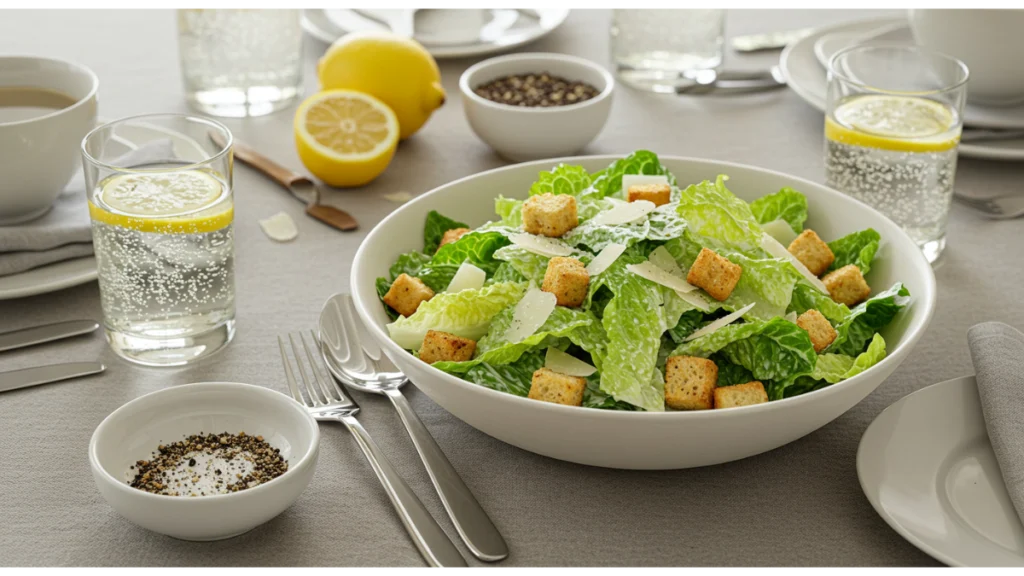Discover the Best Caesar Salad Recipe: A Classic Reimagined
Welcome to the delightful world of Caesar Salad, a dish that has transcended time and trends to become a beloved classic on menus around the globe. With its crisp romaine lettuce, creamy dressing, crunchy croutons, and savory Parmesan cheese, Caesar Salad is more than just a side dish—it’s a culinary experience. In this article, we will explore the origins of Caesar Salad, its health benefits, and an extensive recipe that you can easily recreate at home. Whether you’re looking to impress guests or simply enjoy a delicious meal, this guide will provide you with all the tips and tricks to make the best Caesar Salad ever. Let’s dive into this culinary journey!
Key Aspects of Caesar Salad

Caesar Salad is not merely a salad; it’s a celebration of flavors and textures. Here are some key aspects that make this salad a timeless favorite:
- Historical Significance: The Caesar Salad was invented in the 1920s by Caesar Cardini, an Italian-American restaurateur. The original recipe was created in Tijuana, Mexico, and has since evolved into countless variations, maintaining its status as a staple in American cuisine. The story goes that Cardini whipped up the salad on a busy Fourth of July weekend when his restaurant was running low on supplies. He combined the ingredients he had on hand, and thus, the Caesar Salad was born.
- Flavor Profile: The combination of fresh romaine lettuce, tangy dressing, and savory toppings creates a harmonious balance of flavors. The dressing, made with ingredients like anchovies, garlic, and lemon juice, adds a zesty kick that elevates the salad. The crunch of the croutons contrasts beautifully with the creamy texture of the dressing, making every bite a delightful experience.
- Versatility: While the classic Caesar Salad is delicious on its own, you can incorporate grilled chicken, shrimp, or even roasted vegetables to make it a heartier dish. This adaptability is one reason why Caesar Salad remains popular in various dining settings, from casual lunches to elegant dinners.
Ingredients You’ll Need for Caesar Salad

To prepare a classic Caesar Salad, gather the following ingredients:
- For the Salad:
- One large head of romaine lettuce, cleaned and diced
- 1 cup of homemade or store-bought croutons
- ½ cup of freshly grated Parmesan cheese
- Optional: Grilled chicken or shrimp for added protein
- For the Caesar Dressing:
- 1 clove of garlic, minced
- 2 anchovy fillets (or 1 teaspoon of anchovy paste)
- 1 egg yolk (or 1 tablespoon of mayonnaise for a no-raw-egg version)
- 2 tablespoons of lemon juice
- 1 teaspoon of Dijon mustard
- ½ cup of olive oil
- Salt and freshly ground black pepper to taste
- Optional: A few dashes of Worcestershire sauce for added depth
Step-by-Step Instructions to Make Caesar Salad
Now that we have our ingredients ready, let’s walk through the steps to create the perfect Caesar Salad:
- Prepare the Lettuce:
Begin by rinsing the romaine lettuce thoroughly under cold water. Dry it with a clean kitchen towel or use a salad spinner to eliminate excess moisture. Cut the lettuce into bite-sized pieces and transfer it to a large salad bowl. The freshness of the lettuce is crucial to the overall taste and texture of the salad. - Make the Croutons:
If you’re using homemade croutons, preheat your oven to 375°F (190°C). Cut stale bread into cubes and toss them with olive oil, salt, and garlic powder. Spread the cubes on a baking sheet and bake for about 10-15 minutes, or until golden brown and crunchy. Let them cool before mixing them into the salad. Homemade croutons add a personal touch and enhance the flavor profile of your Caesar Salad. - Prepare the Caesar Dressing:
In a mixing bowl, combine the minced garlic, anchovies, egg yolk (or mayonnaise), lemon juice, Dijon mustard, and Worcestershire sauce. Whisk these ingredients together until well combined. Slowly drizzle in the olive oil while whisking continuously to blend the dressing. Season with salt and pepper to taste. Adjust the consistency by adding a little water if it’s too thick. The dressing is the heart of the Caesar Salad, so take your time to ensure it’s perfectly balanced. - Assemble the Salad:
Drizzle the dressing over the diced romaine lettuce and gently toss to coat the leaves uniformly. Be careful not to over-toss, as you want the lettuce to remain crisp. The key is to have just enough dressing to enhance the flavor without overwhelming the lettuce. - Add Toppings:
Sprinkle the croutons and freshly grated Parmesan cheese over the top of the salad. If you’re adding grilled chicken or shrimp, arrange them on top for a beautiful presentation. This step not only adds flavor but also visual appeal to your dish. - Serve Immediately:
Caesar Salad is best enjoyed fresh. Serve it immediately to maintain the crispness of the lettuce and croutons. You can garnish with additional Parmesan cheese and a sprinkle of black pepper for added flavor. Pair it with a glass of white wine or a refreshing iced tea for a complete meal.
Nutritional Value
Here’s a breakdown of the nutritional value of a classic Caesar Salad (without protein additions):
| Ingredient | Serving Size | Calories | Protein | Fat | Carbohydrates | Fiber |
|---|---|---|---|---|---|---|
| Romaine Lettuce | 1 cup | 9 | 1g | 0g | 2g | 1g |
| Croutons | 1 cup | 120 | 3g | 5g | 18g | 1g |
| Parmesan Cheese | 1 oz | 110 | 10g | 7g | 1g | 0g |
| Caesar Dressing | 2 tbsp | 150 | 1g | 15g | 2g | 0g |
| Total | 389 | 15g | 27g | 23g | 2g |
Benefits of Caesar Salad

Caesar Salad not only pleases the palate but also offers several health benefits:
- Nutrient-Rich: The primary ingredient, romaine lettuce, is low in calories and high in vitamins A, C, and K, as well as folate and fiber. These nutrients support overall health and digestion. The fiber content aids in maintaining a healthy digestive system, while vitamins A and C contribute to skin health and immune function.
- Healthy Fats: The olive oil in the dressing provides monounsaturated fats, which are beneficial for heart health. Additionally, the Parmesan cheese contributes calcium and protein. These healthy fats help to keep you satiated, making Caesar Salad a satisfying option.
- Customizable: You can easily modify the salad to fit your dietary needs. For instance, using grilled chicken or shrimp increases the protein content, making it a more balanced meal. You can also substitute gluten-free croutons for those with gluten sensitivities.
Overcoming Challenges
While making a Caesar Salad is relatively straightforward, here are some tips to overcome common challenges:
- Preventing Soggy Lettuce: Ensure that the lettuce is thoroughly dried after washing. Excess moisture can lead to a soggy salad. Use a salad spinner or pat it dry with a towel. This step is crucial for maintaining the crisp texture of the salad.
- Adjusting the Dressing: If the dressing is too strong, you can dilute it with a bit of water or extra olive oil. Taste as you go to find the right balance for your palate. The goal is to have a creamy dressing that complements the salad without overpowering it.
- Storage Tips: If you have leftover salad, store the dressing separately to prevent the lettuce from wilting. Combine just before serving for the best texture. Leftover dressing can be stored in the refrigerator for up to a week, making it convenient for future salads.
Future Trends
As culinary trends evolve, so does the Caesar Salad. Here are some predictions for the future of this classic dish:
- Plant-Based Alternatives: With the rise of plant-based diets, many are opting for vegan Caesar dressings made with cashews or tahini instead of eggs and anchovies. This trend allows more people to enjoy the flavors of Caesar Salad while accommodating dietary restrictions. These plant-based options can be just as creamy and flavorful as traditional dressings.
- Innovative Ingredients: Expect to see more creative toppings and variations, such as roasted chickpeas for added crunch, or different types of greens like kale or arugula replacing romaine. These additions not only enhance the flavor but also increase the nutritional value of the salad.
- Global Influences: As chefs experiment with global flavors, we may see Caesar Salad infused with ingredients from different cuisines, such as spicy sriracha or Asian-inspired dressings. This fusion approach can introduce exciting new flavors while retaining the essence of the classic salad.
Tips and Tricks Section
Here are some helpful tips to elevate your Caesar Salad experience:
- Homemade Croutons: For the best flavor and texture, make your own croutons using stale bread. Experiment with different types of bread, such as sourdough or whole grain, for unique flavors. You can also season the croutons with herbs and spices for an extra kick.
- Cheese Variations: While Parmesan is traditional, consider using Pecorino Romano or a blend of cheeses for a different flavor profile. Mixing cheeses can create a more complex taste that enhances the overall dish.
- Herb Infusion: Add fresh herbs like basil or parsley to the dressing for an aromatic twist. This addition can brighten the flavor and add complexity. Fresh herbs not only improve taste but also provide additional nutrients.
Variations and Adaptations
Caesar Salad is highly adaptable. Here are some variations to consider:
- Grilled Chicken Caesar Salad: Top your salad with slices of grilled chicken breast for a protein-packed meal. This variation is perfect for those looking to increase their protein intake while enjoying a classic salad.
- Seafood Caesar Salad: Incorporate grilled shrimp or crab meat for a seafood twist. The addition of seafood complements the flavors of the dressing and adds a gourmet touch.
- Vegan Caesar Salad: Substitute the egg yolk with vegan mayonnaise and use nutritional yeast instead of Parmesan cheese for a dairy-free option. This adaptation allows vegans to enjoy the rich flavors of Caesar Salad without compromising their dietary preferences.
FAQs Section
1. Can I make Caesar Salad ahead of time?
Yes, you can prepare the ingredients ahead of time. However, it’s best to store the dressing separately and combine everything just before serving to maintain freshness. This way, the lettuce remains crisp, and the flavors are at their best.
2. What can I substitute for anchovies?
If you prefer not to use anchovies, you can omit them or use a dash of soy sauce or miso paste for umami flavor. These alternatives can provide a similar depth of flavor without the fishiness.
3. How do I store leftover Caesar Salad?
Store any leftovers in an airtight container in the refrigerator. Keep the dressing separate to prevent the lettuce from wilting. The salad is best enjoyed fresh, but you can save the components for later use.
4. Can I use pre-packaged Caesar dressing?
Absolutely! While homemade dressing is delicious, there are many quality pre-packaged options available that can save time. Just be sure to check the ingredient list for quality and flavor.
Conclusion
Caesar Salad is a timeless classic that continues to delight palates around the world. With its rich flavors and satisfying textures, it’s a dish that can be enjoyed in countless ways. By following this comprehensive guide, you’ll be well-equipped to create the best Caesar Salad at home, whether for a casual lunch, a dinner party, or a family gathering. Remember to experiment with ingredients and make it your own. Enjoy the process, and don’t hesitate to share your culinary creations with friends and family!

